Jacopo d'Antonio Negretti, universally known in art history as Palma Vecchio, or "Old Palma," stands as a significant figure in the Venetian School during the High Renaissance. Born around 1480 near Serina, a town close to Bergamo but then part of the Venetian Republic's territories, he moved to Venice itself early in his career. He became one of the foremost painters of his generation, celebrated for his rich use of colour, his sensitive portrayal of figures, and his contribution to popular genres like the sacra conversazione and idealized female portraits. His life, though relatively short, spanned a period of immense artistic ferment in Venice, placing him alongside giants like Giorgione and Titian.
His actual surname was Negretti, but he became known as Palma, possibly a nickname or a family name adopted for professional reasons. The suffix "Vecchio" (Old) was applied posthumously to distinguish him from his great-nephew, Jacopo Palma il Giovane ("Young Palma"), who became a prominent painter in the later 16th century. Palma Vecchio died relatively young, in Venice on July 30, 1528, leaving behind a substantial body of work that continues to enchant viewers with its warmth and serene beauty.
Early Life and Artistic Formation in Venice
Details of Palma Vecchio's earliest training remain obscure. Hailing from the Bergamo region, like fellow artists Lorenzo Lotto and Andrea Previtali, he likely received some initial instruction locally. However, the magnetic pull of Venice, the dominant artistic centre of the region, drew him to the lagoon city, probably in the first decade of the 16th century. Here, he entered an environment buzzing with innovation, largely shaped by the late works of Giovanni Bellini and the emerging talents of Giorgione and the young Titian.
The influence of Giovanni Bellini, the patriarch of Venetian painting, provided a foundational understanding of colour, light, and atmospheric effects. Bellini's late works, with their harmonious integration of figures and landscape, set a standard for devotional painting. Palma would absorb this tradition, particularly the emphasis on colorito – the Venetian focus on colour and brushwork over Florentine disegno (drawing and design) – which became a hallmark of his own style.
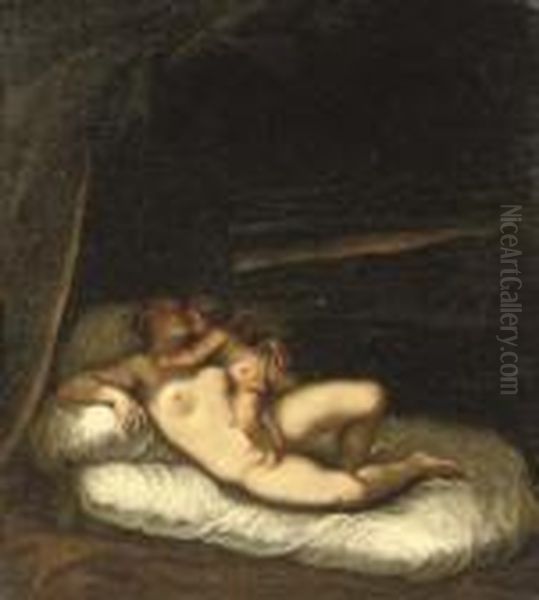
However, the most profound impact on the young Palma came from Giorgione and Titian. Giorgione, though his career was tragically short (d. 1510), revolutionized Venetian painting with his enigmatic, atmospheric compositions, soft modelling (sfumato), and poetic sensibility. Palma clearly studied Giorgione's work, adopting his preference for pastoral themes, his sensuous depiction of the human form, and his ability to evoke mood through light and colour. The influence is so marked that attributions for some works from this period have fluctuated between Giorgione, Titian, and Palma.
Titian, slightly older than Palma and also deeply influenced by Giorgione, quickly rose to prominence. Palma Vecchio appears to have looked closely at Titian's early works, absorbing his dynamic compositions and robust figure types. While some sources suggest Palma may have briefly studied with Titian, it's perhaps more accurate to see them as contemporaries developing alongside each other, initially sharing the Giorgionesque mode before forging their distinct paths. Their relationship would evolve into one of respectful, and sometimes direct, competition.
Development of a Distinctive Style
Throughout the 1510s and 1520s, Palma Vecchio forged his mature style. While indebted to his great contemporaries, he developed a personal idiom characterized by a gentle serenity, a preference for ample, idealized figures, and a particular mastery of depicting textures, especially rich fabrics and luminous flesh tones. His colour palette is typically warm and harmonious, often featuring glowing reds, golds, and deep greens, applied with a soft, blended technique that avoids harsh outlines.
His figures, particularly female ones, often possess a distinctive type: blonde, full-figured, with round faces and a calm, sometimes placid demeanor. This idealization connects him to the Giorgionesque tradition but takes on a more robust, tangible quality in Palma's hands. He excelled at rendering the softness of skin and the sheen of hair, contributing significantly to the Venetian celebration of sensual beauty.
Palma's compositions are generally balanced and harmonious, often favouring horizontal formats, especially in his sacra conversazione and mythological scenes. He skillfully integrated figures into landscape settings, which, while often idealized, possess a convincing sense of light and atmosphere. Unlike the dramatic intensity that would characterize later Venetian painters like Tintoretto, Palma's work generally maintains a mood of peacefulness and lyrical grace.
His technical skill was considerable. He worked primarily in oil on canvas, a medium favoured in Venice for its ability to achieve rich colouristic effects and its durability in the damp climate. His brushwork, while often blended for soft transitions, could also be more descriptive when rendering details like brocades or foliage. He managed a successful workshop, which helped meet the considerable demand for his paintings.
The Sacra Conversazione
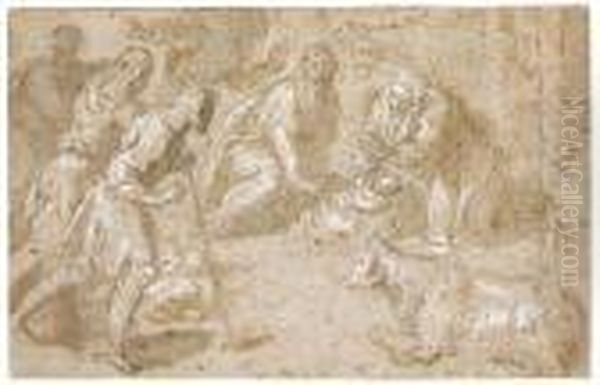
One of Palma Vecchio's most significant contributions was to the genre of the sacra conversazione (holy conversation). These paintings depict the Virgin and Child surrounded by saints, not in a specific narrative moment, but in a timeless, contemplative gathering. Building on the tradition established by Giovanni Bellini, Palma infused these scenes with a warmth and intimacy that proved highly popular with patrons, both for church altarpieces and private devotion.
His sacra conversazione compositions typically feature a balanced arrangement of figures, often set against a landscape backdrop or an architectural niche. The saints interact subtly, through glances or gestures, creating a sense of quiet communion. The Virgin Mary is usually depicted as a serene, maternal figure, embodying an approachable divinity. Palma's skill in rendering rich fabrics is evident in the saints' robes and the Virgin's mantle, adding to the visual splendour of the scene.
A prime example is the St. Peter Enthroned with Six Saints now in the Gallerie dell'Accademia, Venice. Here, St. Peter sits centrally, flanked by saints including John the Baptist, Paul, and Mary Magdalene. The figures are characteristically ample and calm, bathed in a soft, unifying light. The landscape background adds depth and a touch of pastoral serenity.
Perhaps his most celebrated work in this vein, though technically a depiction of a single saint, is the monumental Saint Barbara Altarpiece in the church of Santa Maria Formosa, Venice. St. Barbara stands majestically on a pedestal, flanked by smaller panels depicting Saints Anthony Abbot and Sebastian below, and Saints John the Baptist and Dominic above, with a Pietà in the lunette. The central figure of St. Barbara is one of Palma's most powerful creations – a statuesque, commanding presence rendered with rich colour and exquisite detail, embodying idealized female strength and beauty. This work cemented Palma's reputation in Venice.
Mythological Subjects and Pastoral Ideals
Following the taste established by Giorgione and Titian, Palma Vecchio also painted mythological and allegorical subjects, often set in idyllic pastoral landscapes. These works allowed for a greater exploration of the nude or semi-nude figure and catered to the sophisticated tastes of private collectors who appreciated classical themes imbued with Venetian sensuality.
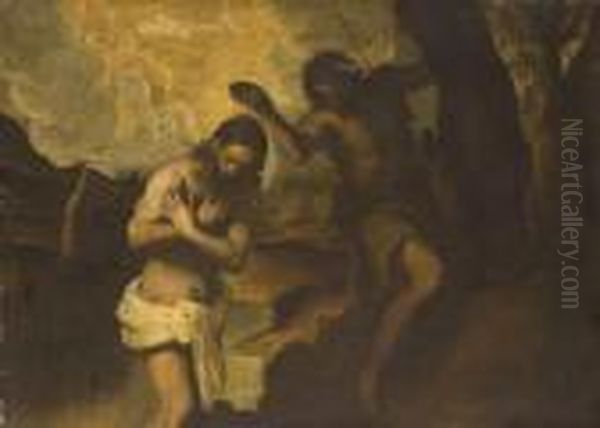
His Jacob and Rachel (Dresden, Gemäldegalerie Alte Meister) exemplifies his approach to Old Testament themes treated in a pastoral mode. The figures are set within a lush landscape, their encounter rendered with a gentle narrative charm rather than high drama. The emphasis is on the beauty of the figures, the richness of the colours, and the harmonious integration of humanity and nature, echoing the Arcadian ideals popularized by Giorgione.
Works like Venus and Cupid (Cambridge, Fitzwilliam Museum) showcase his engagement with classical mythology. Here, Palma presents a typically Venetian interpretation of the goddess of love – sensuous, relaxed, and set within a landscape that enhances the idyllic mood. These paintings often feature the blonde, full-figured female type that became synonymous with his name, contributing to the broader Renaissance exploration of classical antiquity through a distinctly Venetian lens.
These mythological and pastoral works demonstrate Palma's debt to Giorgione's poetic vision but also his own tendency towards clearer narrative and more solidly defined forms compared to Giorgione's often more elusive and atmospheric style. He found a balance between idealized beauty and tangible presence that appealed greatly to his patrons.
Portraits and Idealized Beauties
Palma Vecchio was also a sought-after portraitist, although fewer documented portraits survive compared to his religious and mythological works. His Portrait of a Poet (London, National Gallery), likely depicting Ariosto, shows his ability to capture a sitter's presence and psychological depth, rendered with his characteristic softness of modelling and attention to texture.
However, Palma is perhaps most famous for a particular type of portraiture: idealized representations of beautiful women, often shown half-length or bust-length. These paintings, sometimes referred to by the generic title La Bella ("The Beautiful Woman") or associated with specific names like Violante or Flora, may represent actual courtesans, idealized beauties, or allegorical figures. Works like A Blonde Woman (Vienna, Kunsthistorisches Museum) and The Three Sisters (Dresden, Gemäldegalerie Alte Meister) are prime examples.
These paintings focus on the sensuous appeal of the subject: luminous skin, flowing blonde hair (often intricately braided), rich garments, and a direct yet serene gaze. They are less about individual identity than about celebrating an ideal of feminine beauty highly prized in Renaissance Venice. Palma's mastery in rendering textures – velvet, silk, fur, pearls, and soft flesh – is particularly evident in these works. They catered to a specific market of wealthy patrons and significantly influenced subsequent Venetian painters, including Titian himself, whose own famous Flora shares characteristics with Palma's beauties.
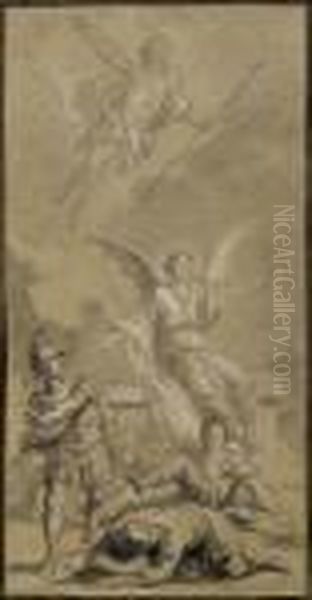
This genre solidified Palma's reputation as a master of depicting female beauty, a theme noted even by the contemporary chronicler Marcantonio Michiel and later by Giorgio Vasari in his Lives of the Artists. While sometimes criticized for a certain uniformity in type, these works remain captivating examples of Venetian High Renaissance aesthetics.
Workshop and Influence
Like many successful Renaissance artists, Palma Vecchio maintained a large and active workshop to help him fulfill numerous commissions. This was essential for producing the quantity of altarpieces, devotional paintings, and decorative works demanded by churches, confraternities, and private patrons throughout the Venetian territories. The workshop system allowed for the replication of popular compositions and the training of younger artists in the master's style.
The most significant artist known to have emerged from Palma's circle was Bonifacio de' Pitati, often called Bonifacio Veronese (though not related to Paolo Veronese). Bonifacio absorbed Palma's style, particularly his rich colour and compositional types, and went on to have a successful independent career, further disseminating Palma's influence. Other artists from the Bergamo region working in Venice, such as Giovanni Cariani, also show stylistic affinities with Palma, suggesting a network of exchange and influence among artists from the Venetian mainland.
Palma's influence extended beyond his immediate pupils. His popularization of certain compositional types, particularly the horizontal sacra conversazione with landscape backgrounds and the half-length idealized female portrait, had a lasting impact on Venetian painting throughout the 16th century. Artists like Paris Bordone and Andrea Schiavone, while developing their own styles, show awareness of Palma's achievements, particularly in their treatment of colour and sensuous figure types.
The productivity of his workshop means that attributions can sometimes be complex, with varying degrees of autograph work (by Palma himself) versus workshop participation. However, the overall quality and stylistic consistency associated with his name testify to his effective management and the high standards he maintained.
Relationship with Contemporaries: Titian, Lotto, and Others
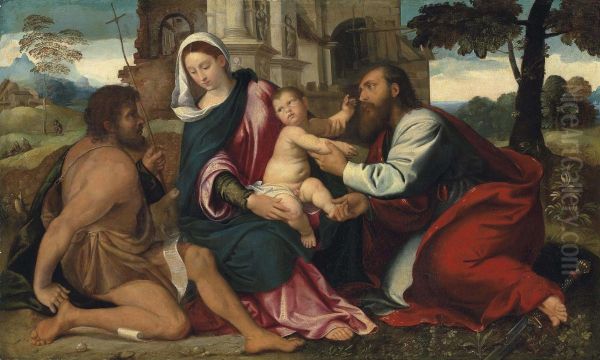
Palma Vecchio's career unfolded in the shadow of, and sometimes in direct competition with, Titian. While Palma carved out his own niche, particularly with his serene sacra conversazione and idealized beauties, Titian's ambition, range, and powerful patronage connections eventually established him as the dominant figure in Venetian art after the deaths of Bellini and Giorgione. There seems to have been a degree of rivalry, perhaps friendly, perhaps more pointed at times, as both artists vied for important commissions. Palma's style, while influenced by Titian's dynamism, generally retained a calmer, more lyrical quality. Some later accounts suggest Titian may have even finished some works left incomplete at Palma's death, though this is debated.
His relationship with Lorenzo Lotto, another major artist from the Bergamo area working partly in Venice, appears to have been one of mutual respect and perhaps friendly competition. Lotto's style was more idiosyncratic, marked by psychological intensity, cooler colours, and sometimes unconventional compositions, contrasting with Palma's generally more harmonious and idealized approach. Both artists, however, catered to similar markets for altarpieces and portraits, representing different facets of the rich artistic production of the era.
Palma also navigated the broader artistic landscape of Venice. He would have been aware of the narrative cycles of Vittore Carpaccio, the refined classicism of Vincenzo Catena, and the Bellini-esque clarity of Cima da Conegliano. He also worked alongside artists like Sebastiano del Piombo in the early Giorgionesque phase before Sebastiano departed for Rome. Later figures like Giovanni Gerolamo Savoldo, known for his dramatic nocturnal scenes and Lombard realism, offered different stylistic alternatives within the Veneto-Lombard artistic sphere. Palma's consistent adherence to a richly coloured, harmonious High Renaissance style set him apart within this diverse environment.
The Palma Legacy: Palma il Giovane
The name "Palma" continued to resonate in Venetian art through Palma Vecchio's great-nephew, Antonio Negretti's grandson, also named Jacopo Palma (c. 1548/50–1628). To avoid confusion, the younger artist became known as Palma il Giovane ("Palma the Younger"). Palma Giovane's career began decades after his great-uncle's death, and his style belongs to a later phase of Venetian art, deeply influenced by Tintoretto and Veronese, and bridging the gap towards the Baroque.
Palma Giovane was incredibly prolific and became one of Venice's leading painters following the deaths of Titian (1576) and Tintoretto (1594). He famously completed the Pietà that Titian left unfinished in his studio. His style is generally more dramatic, dynamic, and characterized by looser brushwork and darker palettes than that of Palma Vecchio, reflecting the Mannerist and proto-Baroque tendencies of the late 16th century.
The distinction between Palma Vecchio and Palma Giovane is crucial for understanding Venetian art history. While sharing a name and family connection, they represent different generations and stylistic phases. Palma Vecchio embodies the serene beauty and colouristic richness of the High Renaissance, while Palma Giovane represents the energy and drama of the late Renaissance and the transition towards the Baroque.
Later Life, Death, and Reputation
Palma Vecchio seems to have enjoyed considerable success and esteem during his lifetime. He received numerous commissions from important Venetian churches and patrons. Unlike some of his contemporaries, he appears never to have married and dedicated his life primarily to his art. Accounts suggest a relatively untroubled existence, focused on managing his busy workshop and producing the paintings that were clearly in high demand.
His relatively early death in 1528, likely in his late forties, cut short a flourishing career. He died in Venice and was buried there. Giorgio Vasari, in his Lives of the Most Excellent Painters, Sculptors, and Architects (1550, revised 1568), included a biography of Palma Vecchio. While Vasari, a proponent of Florentine disegno, sometimes offered qualified praise for Venetian colourists, he acknowledged Palma's skill, particularly his pleasing colour and his diligence. Vasari specifically noted Palma's reputation for painting beautiful women and commented on his somewhat leisurely pace, though Palma's output suggests considerable industry, likely aided by his workshop.
Over the centuries, Palma Vecchio's reputation has remained solid, though perhaps overshadowed at times by the towering figures of Giorgione and Titian. He is recognized as a key exponent of the Venetian High Renaissance, a master colourist whose works embody a particular type of serene, sensuous beauty. His paintings continue to be admired in major museums worldwide for their technical finesse, harmonious compositions, and quintessential Venetian warmth.
Conclusion: A Master of Serene Beauty
Jacopo Palma il Vecchio occupies a vital place in the constellation of Venetian High Renaissance painters. Emerging in the wake of Giovanni Bellini and alongside the revolutionary talents of Giorgione and Titian, he synthesized their innovations into a distinct personal style characterized by rich colour, soft modelling, and idealized, ample figures. His contributions to the sacra conversazione, his mastery of mythological and pastoral themes, and his celebrated depictions of Venetian beauties secured his reputation among patrons and influenced fellow artists.
Though his life was relatively short, his prolific output, aided by an efficient workshop, left a significant mark on Venetian art. He navigated the competitive artistic environment of early 16th-century Venice, holding his own alongside giants like Titian and Lotto. While perhaps not possessing the groundbreaking originality of Giorgione or the universal range of Titian, Palma Vecchio perfected a vision of serene, harmonious beauty, rendered with a consummate skill in handling oil paint and colour. His works remain enduring testaments to the visual splendour and poetic sensibility of the Venetian Renaissance. He is rightly remembered as Palma Vecchio, the elder master whose art continues to radiate warmth and grace.